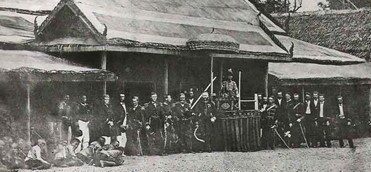Parnreutai Chaiyasat
Bangkok, Thailand

King Mongkut,1 the second son of King Rama II of Siam (now known as Thailand),2 spent most of his life in scholarship as a Buddhist monk before ascending to the throne. He studied traditional Siamese astrology, scientific astronomy, and mathematics.
In August 1868, he predicted the time of a solar eclipse more accurately than a group of French astronomers. He invited them to join him and his entourage to Prachuap Kiri Khan in the south of Thailand to observe the event. The timing of the eclipse verified the king’s calculations, but tragedy struck as he and many of the French delegation were bitten by mosquitoes. They all became infected with an aggressive strain of malaria. Crown Prince Chulalongkorn was with them and also contracted the disease. Seven of the French astronomers died, though the prince survived to follow his father to the throne.
The court poet Sunthorn Phu documented Mongkut’s final weeks. He was a gifted writer, held in high esteem for his observations, imagination, and sensitivity. He had written, in the early 1800s, two of the greatest works of Thai literature: Nirat Meuang Klaeng, a lyrical, poetic account of his journey, and tales of a fictional Siamese prince, Phra Aphai Mani. They have been translated into English and are worth reading.3
On August 26th, 1868, King Mongkut fell ill. His symptoms, as noted by his adopted son in the royal archives, included hypersensitivity to changes in temperature and excessive sweating. Unfortunately, his condition did not improve, resulting in him not tending to his duties. He bled from the bowels, but he pretended to eat normally, and told his attendants to be glad since he was getting better. He ordered the Crown Prince, who was visiting, to stay by his side. Knowing he was dying, he asked that his body not be used for any occult rituals.

King Mongkut then expressed his final wishes. He said: “Today, at midnight, full moon, my life will end.” He said goodbye to the people who were by his side. He said that when he had been a monk, on every birthday he had wished to die on the same date, which would be a day with a full moon. He asked Sunthorn Phu to document his last moments and to fulfill his duties in Buddhist ceremonies. At night, he asked his adopted son to observe him lying on his side, facing west as he would die.
Mongkut’s death was a great loss for Siam; he was celebrated, respected, and much loved. He did much to industrialize the country and change attitudes. Queen Victoria sent him a working railway steam engine, and the gold Siamese crown he gave her remains in Windsor Castle to this day. King Mongkut was dubbed “the father of science and technology in Siam.” The palace archive describes that in the last moments of his life, the king stuck firmly to his Buddhist beliefs as he prayed. The king then passed away in the position of the reclining Buddha at Wat Pa Phu Kon in the Grand Palace, Bangkok, on October 1, 1868.2
End notes
- His full name was Phra Bat Somdet Phra Menthora Ramathibodi Sri Sinthara Mahamakut Phra Mongkut Phra Siam Deva Mahamakut Wittaya Mahara.
- “Mongkut.” Wikipedia. https://en.wikipedia.org/wiki/Mongkut.
- Both works were translated by Prince Prem Bhurachat. Phra Aphai Mani (1952) can be read free online at: https://sakchaip.tripod.com/bookworm/sunthorn/abhai_a.html. Relevant passages from his account of the king’s passing were translated into English for this paper.
Further reading
- Chaophraya Mahinthrasakthamrong. Record on the Sickness of Phra Bat Somdet Phra Chomklao Chaoyuhua. Bangkok: Phrachan Printing House, 1947. Accessed via Wikimedia.
- World Health Organization. “Malaria.” https://who.int/news-room/fact-sheets/detail/malaria.
Acknowledgement
I am grateful to Professor Stephen Martin for an early reading of my text.
PARNREUTAI CHAIYASAT is currently majoring in premedical studies at Triam Udom Suksa in Bangkok, Thailand. She spent an exchange year in the United States.

Leave a Reply